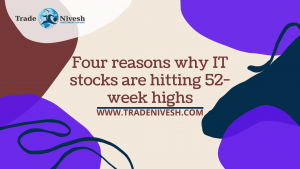Trade Before Wednesday Top 10 Things to Know | Trade Nivesh
Trade Nivesh | Trade Before Wednesday Top 10 Things to Know
Put composing was seen at 11,000 strikes, which included 2.21 lakh contracts, trailed by 11,300 strikes, which included 1.35 lakh contracts, and 11,200 strikes which included 99,675 agreements.
The market recaptured quality on September 1 following a day of significant amendment found over the most recent three months. The assembly was driven via auto, budgetary administrations, FMCG, metals, and pharma stocks.
The BSE Sensex climbed 272.51 focuses on 38,900.80, while the Nifty50 rose 82.80 focuses to 11,470.30, shaping Long Legged Doji sort of example on the day by day outlines as shutting was close to opening levels.
“Tuesday’s upside skip might be a minor supporting variable bull to make a rebound, yet the market is relied upon to switch down from the highs in the following 1-2 meetings. The ongoing swing high of 11,794 is probably not going to be penetrated on the upside temporarily. Prompt help is set at 11,365,” Nagaraj Shetti, Specialized Exploration Examiner at HDFC Protections, told Moneycontrol.
“Every day RSI has turned beneath essential 60 levels. According to its bullish high low scope of 75-40 levels, it could slide down to bring down 40 over the timeframe. Consequently one should be cautious about the resumption of further shortcoming from somewhat more elevated levels,” he said.
The more extensive business sectors likewise made strides with the Clever Midcap file rising 0.82 percent and Smallcap up 0.37 percent.
“After the dreary Gross domestic product information, market members are currently seeking after more upgrade bundle declarations from the administration. Then, members would keep a nearby watch on India-China fringe pressure and worldwide business sectors for prompts. Signs are in the kindness of solidification,” Ajit Mishra, VP-Exploration, Religare Broking, said.
We have examined 15 information focuses to assist you with spotting productive exchanges:
Note: The open intrigue (OI) and volume information of stocks given in this story are the totals of three-month information and not of the current month as it were.
The key support and resistance levels on the Nifty
According to pivot charts, the key support level for the Nifty is placed at 11,373.57, followed by 11,276.93. If the index moves up, the key resistance levels to watch out for are 11,560.17 and 11,650.13.
Clever Bank
The Bank Clever increased 57.65 focuses to close at 23,812 on September 1. The significant rotate level, which will go about as pivotal help for the file, is put at 23,456.9, trailed by 23,101.8. On the upside, key opposition levels are put at 24,183.4 and 24,554.8.
Call Option Data
Greatest Call open enthusiasm of 19.38 lakh contracts was seen at 12,000 strikes, which will go about as essential opposition in the September arrangement. get call put option services
This is trailed by 11,500 strike, which holds 17.52 lakh contracts, and 11,800 strikes, which has gathered 12.70 lakh contracts.
Call composing was seen at 12,200 strikes, which included 54,975 agreements, trailed by 12,100, which included 26,550 agreements.
Call loosening up was seen at 11,400 strikes, which shed 72,225 agreements, trailed by 11,600 strikes, which shed 66,675 agreements, and 11,500 strikes, which shed 62,400 agreements.
Put Option Data
The Greatest Put open enthusiasm of 28.30 lakh contracts was seen at 11,000 strikes, which will go about as significant help in the September arrangement.
This is trailed by an 11,300 strike, which holds 14.38 lakh contracts, and 11,200 strikes, which has collected 12.68 lakh contracts.
Put composing was seen at 11,000 strikes, which included 2.21 lakh contracts, trailed by 11,300 strikes, which included 1.35 lakh contracts, and 11,200 strikes which included 99,675 agreements.
Put loosening up was seen at 11,500, which shed 92,100 agreements, trailed by 11,400 strikes which shed 65,550 agreements.
Stocks with a high conveyance rate
A high conveyance rate proposes that financial specialists are demonstrating enthusiasm for these stocks.
44 stocks saw long develop
In view of the open intrigue future rate, here are the best 10 stocks wherein long development was seen.
18 stocks saw long loosening up
In view of the open intrigue future rate, here are the best 10 stocks wherein long loosening up was seen.
21 stocks saw short develop
An expansion in open enthusiasm, alongside a lessening in cost, generally demonstrates the development of short positions. In light of the open intrigue future rate, here are the best 10 stocks wherein short development was seen.
54 stocks saw short-covering
An abatement in open enthusiasm, alongside an expansion in cost, generally demonstrates a short-covering. In light of the open intrigue future rate, here are the main 10 stocks wherein short-covering was seen.
Mass arrangements
CG Force and Modern Arrangements: Finquest Monetary Arrangements sold 40 lakh partakes in the organization at Rs 23.80 per share through mass arrangements on the BSE.
Future Ventures DVR Class B shares (Arrangement 1): Vivek Saraogi sold 4,69,351 offers in the organization at Rs 22.72 per share.
Future Market Systems: Jugalkishore Mohanlal Maheshwari sold 4,38,311 offers in the organization at Rs 29.3 per share.
(For more mass arrangements, click here)
Income on September 2
Coal India, Arvind Designs, Bannari Amman Sugars, Dish television India, Infibeam Roads, Joyous FoodWorks, Kernex Microsystems, Navkar Enterprise, Sadbhav Building, Sandur Manganese, Glossy silk Creditcare System and so forth will report their June quarter profit on September 1.
Stocks in the news
Coal India: August temporary offtake rose to 44.3 million tons versus 40.6 million tons YoY.
Legend MotoCorp: Deals in August 2020 hopped to 5.84 lakh units versus 5.43 lakh units YoY.
NMDC: Absolute August iron mineral deals at 1.79 million tons versus 1.49 million tons YoY.
Spandana Sphoorty Money related Q1: Benefit at Rs 58.93 crore versus Rs 93.37 crore, income at Rs 325.96 crore versus Rs 298.2 crore YoY.
JB Chemicals and Pharma: Tau Ventures Property Pte Ltd and PACs procured a 10 percent stake in the organization through off-market exchanges during August 31 and September 1, at a cost of Rs 745 for each offer.
ONGC Q1: Independent benefit at Rs 496 crore versus loss of Rs 3,098.3 crore, income at Rs 13,011.3 crore versus Rs 21,456.2 crore QoQ.
Infosys: The organization expanded the US employing pledge to 25,000 by 2022.
TVS Engine: Absolute deals at 2.87 lakh units in August 2020 against 2.90 lakh units in August 2019.
VST Turners and Work vehicles: Force Turners deals at 2,638 units in August 2020 against 1,437 units in August 2019. Farm trucks at 897 units against 813 units in a similar period.
FII and DII information
Unfamiliar institutional financial specialists (FIIs) net purchased shares worth Rs 486.09 crore, while residential institutional speculators (DIIs) net sold offers worth Rs 775.23 crore in the Indian value market on September 1, according to temporary information accessible on the NSE.
Stock under F&O prohibition on NSE
Two stocks – Indiabulls Lodging Fund and Vodafone Thought – are under the F&O boycott for September 2. Protections in the boycott time frame under the F&O portion remember organizations for which the security has crossed 95 percent of the market-wide position limit.


 Aurobindo reported Revenue growth of 8.8% YoY (-3.8% QoQ) to INR 59.2 bn, led by the US, & Antiretroviral business. Formulation business grew 9.2% YoY( -4.8% QoQ, ~87% of revenue) while API rose 6.5% YoY (+3.2% QoQ, ~13% of revenue). EBITDA for the quarter rose 9.7% YoY (-4.5% QoQ) to INR 12.6 bn while EBITDA margin expanded 17 bps YoY/ (down 15 bps QoQ) to 21.2% in 1QFY21 (from 21.1% last year). Adj Net Profit rose 20.4% YoY (-6.8% QoQ) to INR 7.8 bn. Adj. Net Profit Margin for the quarter expanded 126 bps YoY to 13.2.0% (down 43 bps QoQ) from 11.9% in 1QFY20. Reported PAT came at INR 7,806 mn (+22.8% YoY, -8.1% QoQ). Investment in Research for the quarter was INR 2.5 bn at 4.3% of revenue. Net organic capex for the quarter was ~USD 49 million. Aurobindo received final approval for 10 ANDAs from USFDA during the quarter. Company announced an interim dividend of INR 1.25/share for FY20-21.
Aurobindo reported Revenue growth of 8.8% YoY (-3.8% QoQ) to INR 59.2 bn, led by the US, & Antiretroviral business. Formulation business grew 9.2% YoY( -4.8% QoQ, ~87% of revenue) while API rose 6.5% YoY (+3.2% QoQ, ~13% of revenue). EBITDA for the quarter rose 9.7% YoY (-4.5% QoQ) to INR 12.6 bn while EBITDA margin expanded 17 bps YoY/ (down 15 bps QoQ) to 21.2% in 1QFY21 (from 21.1% last year). Adj Net Profit rose 20.4% YoY (-6.8% QoQ) to INR 7.8 bn. Adj. Net Profit Margin for the quarter expanded 126 bps YoY to 13.2.0% (down 43 bps QoQ) from 11.9% in 1QFY20. Reported PAT came at INR 7,806 mn (+22.8% YoY, -8.1% QoQ). Investment in Research for the quarter was INR 2.5 bn at 4.3% of revenue. Net organic capex for the quarter was ~USD 49 million. Aurobindo received final approval for 10 ANDAs from USFDA during the quarter. Company announced an interim dividend of INR 1.25/share for FY20-21.



